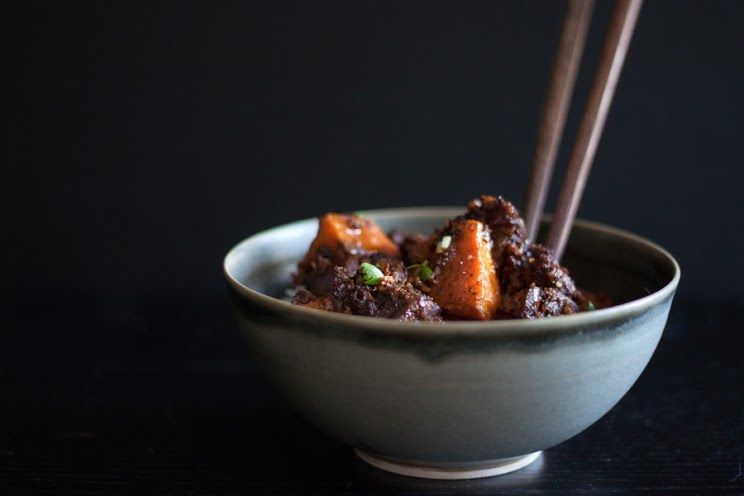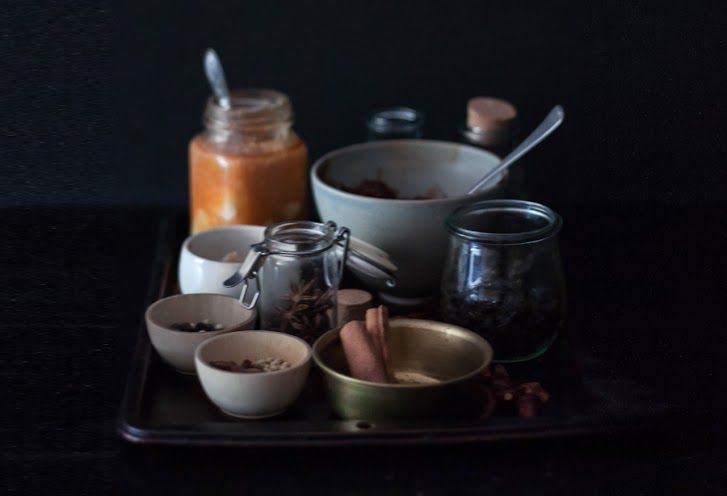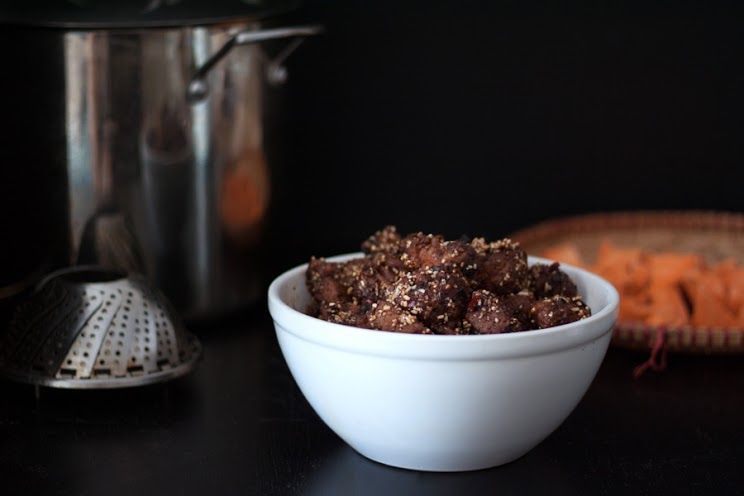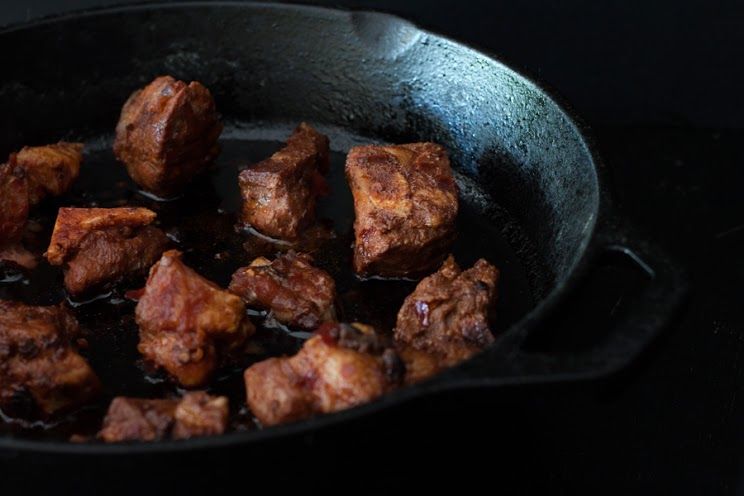Fen Zheng Rou translates literally as “powder steamed meat”. While this title does tell you what the dish is in the most efficient of terms, in no way does it convey the ultimate comfort of a glorious mound of juicy pork wrapped protectively with bits of toasted rice.
The dangerous and fiery nature of Sichuan cuisine is certainly well-known, and chile peppers—fresh, dried, and pickled—are at its heart. But there is so much more depth and breadth to the cuisine’s astounding flavors and techniques that is so often overlooked in the West. This dish is a true representation of that depth. In fact, it might just be the best Sichuan dish you’ve never tasted.
My mom’s dinner parties were never-to-be-missed occasions and our friends loved her cooking. But oddly for the first nineteen years of my life, the scope of my kitchen knowledge started with boiling water for noodles and ended at preparing rice in a rice cooker and wrapping dumplings. Besides occasionally helping my mom with the previously-mentioned all-important skills, I was always far more preoccupied with the joys of eating. Cooking was the tedious extra step leading up to eating and better left to the more than capable hands of my mom. But I was, of course, always on hand for a taste test.
For me, learning to cook only came about out of desperation in college. I couldn’t eat another plate of goopy Fettucine Alfredo or bowl of wet cornstarch-covered vegetables and chicken “stir-fry” over rice—you know the kind. Dreams of eating my favorite foods whenever I wanted made me realize that I needed to grow up and learn to cook. When I called my mom for cooking advice, she responded in the way only a cook with forty years of experience can respond. “It’s not hard to make at all,” she would tell me over the phone, “you just have to use a big spoonful of doubanjian (broad bean paste), some fermented black beans, a few spoonfuls of fermented tofu brine, and a little box of ready-made rice powder.” But what type of spoon and how much is a few, mom?
So how did my first attempt turn out? Absolutely inedible. The rice coating was sparsely cooked and still crunchy. Somehow the whole thing was in parts bland and other parts painfully salty. It would take several more attempts before I’d finally experience the delicious and tender morsels of my childhood. Who would have thought that I actually needed to mix the sauce and rice thoroughly in with the meat before steaming? So thats the end of the story right? Not quite. Because there is absolutely nothing like living with a recipe for years and years. It is like a child that refuses to stay still.
As one of the first dishes I ever attempted, I can trace my growth as a cook through the iterations this dish has gone through. It took several years and quite a few versions to arrive at this recipe. Here is what I learned:
- Regarding the rice powder: For the longest time, I used the premade rice powders my mom had always used. But as I improved as a cook and learned the importance of using whole spices in my cooking, I started to play around with homemade rice powder. While you do have to toast and grind your own rice and spices, these two additional extra steps mean a world of difference. The whole spices create an intensity of flavor that the boxed powder couldn’t begin to replicate. My final mix is loosely based around Chinese five spice powder but with the added funk of cumin and coriander seeds. I also use allspice instead of cloves for a more complex flavor profile.
- Regarding the meat and the sweetness: A fattier cut is definitely the way to go. The long cooking time really lends itself well to spare ribs, country ribs, or pork belly. Beef short ribs are also great. Oftentimes, my mom would do a meat-only version, but I think that the sweet potato is an absolute must. The sweetness of the potato offers the perfect complement to the spices and cuts through the richness of the meat. A nice pumpkin or squash would also work well.
- Browning the meat: As any good cook knows, the added step of browning can make a big difference. It isn’t something that my mom ever did for this recipe, but I have found that browning the meat before steaming really seals in the flavors of the broad bean paste, fermented black beans, and soy sauce. It also creates a great contrasting texture in a dish that is essentially all soft. The crusty bits leftover in the pan from the browning also add deep rich flavor.
Pork Ribs and Sweet Potatoes Steamed with Spiced Rice Meal (Fen Zheng Rou)
Serves 4 to 5
For the Spiced Rice Meal:
1/4 teaspoon coriander seeds
1/2 teaspoon cumin seeds
1/2 teaspoon whole black peppercorns
1/2 teaspoon whole sichuan peppercorns
1/2 teaspoon whole allspice
1/4 stick cinnamon, cassia bark (also known as Indian cinnamon) preferred
1 star anise
1 black cardamom
4 dried hot Sichuan chiles
1/2 cup white rice, like jasmine rice
For the Pork and Sweet Potatoes:
2 pounds pork country ribs or spare ribs, cut into 1 1/2-inch chunks
2 tablespoons Pixian broad bean paste, roughly chopped
1 tablespoon fermented black beans, roughly chopped
3 tablespoons fermented chile tofu brine (optional)
5 tablespoons soy sauce, divided
Grapeseed oil, as needed
1 1/2 inch piece ginger, peeled and sliced
5 large cloves garlic, peeled and sliced
5 dried hot Sichuan chiles, de-stemmed and broken into halves
2 tablespoons Shaoxing cooking wine or other rice wine
2 medium sweet potatoes, cut on a diagonal into rough 2-inch chunks
Cilantro, chopped for serving





See what other Food52 readers are saying.